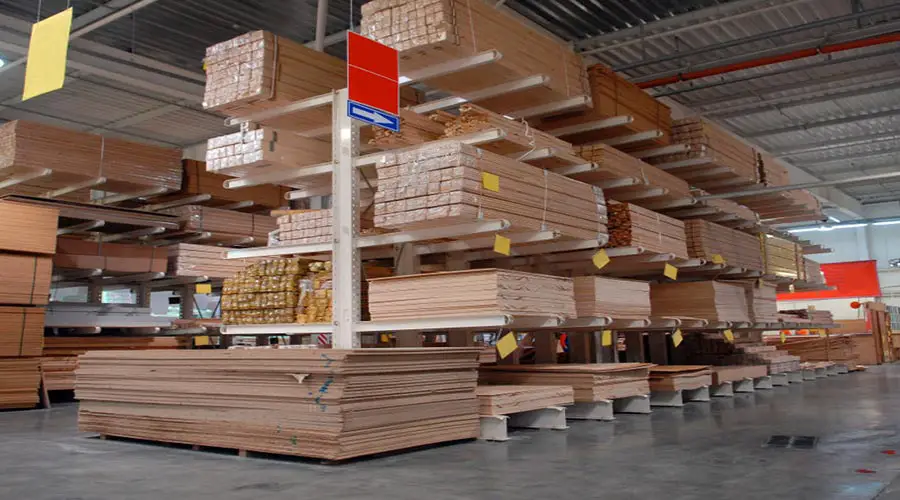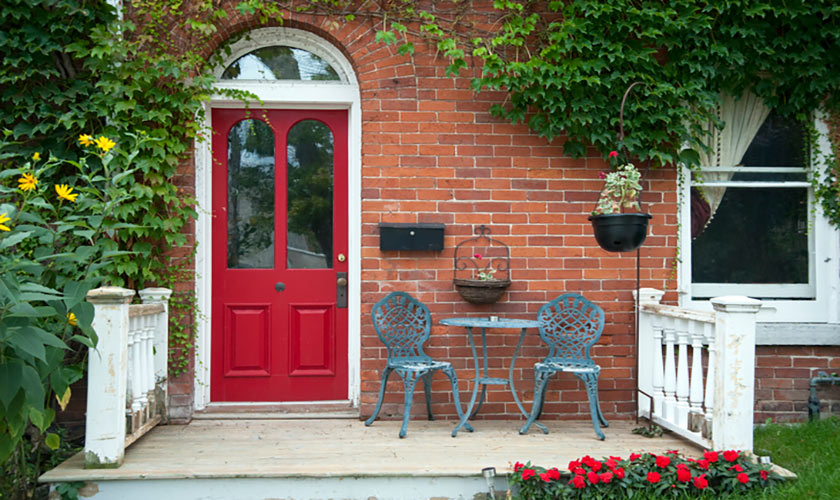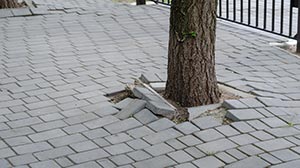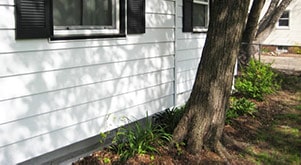
Tree roots know no bounds and tend to maneuver or defer the odds by going straight through a barrier, especially if it has a crack on its surface. When you plant a tree with a big mesh of roots near the foundation of a building, it stands to face the wrath of Mother Nature.
There should be a distance equal to the tree’s height or the canopy radius between the tree and any foundation, whichever distance is greater. In a case study, 75% of trees grew 8 to 30 feet tall. A 10-foot tall tree with a canopy diameter of 24 feet should be 12+ feet away from all structures.
Trees belong to nature, and nature can be very unforgiving. Tree roots supply the tree with water and nutrients. When the surrounding soil lacks sufficient food, the tree’s roots can travel quite far across and below ground, searching for the proper nutrients.
How Far Should Trees Be From The Foundation?
If you are considering planting trees to add beauty to your landscape or any other reason, it is essential to consider the type of tree and the size the same tree will attain in full glory. Trees vary in height and stature. While some trees are overgrown, others are slower and tall or bound by nature to be short.
Tall trees near a house can be disastrous in many situations. For safety reasons, it’s important to plant trees a reasonable distance from all structures, homes, and foundations. Small and medium flowery trees, like the jacaranda tree, should be planted at least 10 feet from the house.
Like oaks and cypress, other larger trees should be set at least 15 to 30 feet from the house. Their roots are long and thick to complement and supplement their enormous trunk and big branches.
The type of soil in your yard matters a lot to the livelihood of trees as well. Trees feed on water and nutrients, and their availability in the soil determines the tree’s growth and the condition it will leave the surrounding soil.
Clay soil is full of nutrients, but it can become extremely dry during dry seasons. Trees planted in clay soil do good but tend to dry up the ground, impacting a house’s foundation and structural integrity.
What Is the Minimum Distance Between a Building and a Tree?
Most homes are not privileged to have large yards. So when you talk and think of the minimum distance a tree should be to a house, you would often think of flowering or fruit trees that do not take up much space.
The good thing with fruit trees or flowering trees is that most remain relatively small in the tenure of their long lives. When a tree is small, it means that its roots are not too long either, so they do not invade nearby structures and concrete surfaces.
The roots of these trees grow 5 to 15 feet in breadth, so they become the best trees to plant nearer to a house in cases where space is limited. The ideal distance these types of trees should be from home is 15 to 20+ feet.
A few examples of common fruit and flowering trees found in yards are:
- White fringe tree
- Kousa dogwood
- Star magnolia
- Crabapple (also known as malus)
- Maple trees
See our article 15 Simple Plants That Won’t Harm Your House Foundation.
The Effects Tree Roots Can Have On Foundations
Trees are beautiful but come with their fair share of trouble. Let us concentrate on the disadvantages of growing trees too near to a building for today. Trees grow vertically as well as horizontally. More giant trees have a carrot-like taproot that grows straight deep into the ground and is synonymous with oak trees and similar species.
However, most trees grow a web of roots extending in all directions. In some cases, these roots are visible, but in most, they are not.
Many people wonder why most urban trees have their roots protruding from the ground because the sole purpose of trees is to collect water and minerals (nutrients). During the construction process of houses and buildings, the soil from deep down was taken to the top.
The soil from deep under contains so many nutrients that are beneficial to trees, and it is often at the surface because of construction, so all tree roots have to do is linger at the surface to get all the nutrients it needs.
While some trees sprout and establish their firmness very fast, others grow slowly but achieve strength and height in the long run.
Most trees have a web of secondary roots that are not very deep but are very efficient in absorbing minerals and water available on the ground’s surface. The more the roots of a tree elongate towards a building, the more imminent the damage they pose becomes.
Below are some of the damages trees roots can impart on buildings and their foundations:
1. Soil and Ground Stability
As trees consume water and nutrients from where their roots reach, the soil, especially clay, dries up and starts to crack. In most cases, you will find that as the roots grow and seep out all the water from the surrounding areas, the roots knead up the soil, and it becomes compact.
One of the reasons for tree planting is to hold up the soil to prevent erosion.
In this case, where roots are close to a building, it could be dangerous to pull out the tree’s roots after it has been cut down as it will destabilize the soil around the building when the now free ground rehydrates loosens up, shaking the foundation.
2. Entering the Foundation Through Existing Cracks
Because of other reasons far from an impact from tree roots, the walls and the foundation of a building could have existing cracks.
As tree roots linger around trying to find direction and all, they are more likely to stem through the foundation or walls by penetrating through the existing cracks, expanding, and causing more damage in the process.
3. Roots Can Lift and Destabilize a Foundation
In some cases where a tree’s roots can travel far and wide, the roots are capable of finding their way under the surface of the foundation as it maneuvers the stone and concrete foundation in search of more water and nutrients.
In the beginning, you won’t notice any change as the tree’s roots are still thin and feeble, but with time, the roots grow big and firm to the extent of lifting or destabilizing the foundation that is now standing on its path.
What to Do When There are Existing Trees Close to the Foundation
Planting trees too close to a building is terrible, but there are cases and scenarios where you buy a house with trees too close to the home’s foundation and feel like doing something about it.
Here are two things for you to consider:
- Cutting the trees down to save the house from damage
- Erecting a tree root barrier to curb further growth
Cutting Down of Trees
Trees are essential in the lives of humans as they improve the visual image of a home aside from providing shade, acting as a protective shield, muffling excessive noise from the outside world, and cleansing the air. But some trees sometimes get too close for comfort, especially when the roots are infringing on the walls and the foundation upon which the home stands.
When a tree is too close to a foundation, it is perfectly okay to consider cutting down the tree. Even when the natural ecosystem relies on it, you should not feel guilty about wanting the best for your home. The closest a big tree should be to a home’s foundation is 15 feet at a minimum.
When you cut down a tree, it is honorable to replace it. If you don’t like the location, you could compensate by planting a tree or two somewhere else.
But cutting down a tree is not enough as the roots are still in place, and some trees have a peculiar habit of sprouting back to life.
You should destroy the roots, and it is imperative to note that you should be very careful when pulling out the stem and roots of a tree that is well established. It is because the pressure asserted when pulling the root out could damage a building. It is crucial to get a permit and enlist an arborist’s services to cut down a tree.
Erecting Tree Barriers
Root barriers are intentional means of deterring tree roots from growing in a specific direction. However, they apply best to younger trees whose roots are yet to go deeper or broader.
A root barrier becomes the most sensible option when you do not want to cut down a tree but are still worried about the damage its roots could cause or have already caused. Typically, root barriers have a measurement of 24 inches in diameter and a depth of 18 inches.
The science behind the root barrier is to allow tree roots to grow horizontally to a maximum of 12 inches wide. When they hit a dead end, they redirect their direction downwards but are still deterred by the barrier but regain freedom when they attain an 18-inch depth.
Knowing When the Root of a Tree is Damaging the Foundation
Most tree roots are not visible from the ground, and it would be impossible to tell when they are about to wreak havoc until it’s too late.
- Tree roots suck up water and nutrients as they travel along. In its wake, the surrounding soil dries up and loosens. When the foundation of a building was installed, the ground was moist, but now it has no water.
- The chances that the soil will loosen up is excellent. In doing so, the foundation is destabilized and leans towards the damaged area.
The problem is not with the tree but with the person who planted it, as they did not consider the house’s proximity and foundation. One way to sort out this problem in the meanwhile is to supply the tree with water to prevent further significant damage to the foundation.
Pros and Cons to Having Trees Near Your Home
A home with trees in its yard is calm and peaceful. It’s like stepping into a different world, primarily if the house is in an urban setting. The trees popularly planted and grown in yards include birch, poplar, willow, cypress, rowan, elm, oak, and lime trees.
But as much as many desire to have trees in their yards, the same trees could threaten nearby building foundations. Let’s look into how tree roots can negatively affect the foundation of a building and a few of the benefits that trees can have.
Benefits to Having Trees Near Your Home
- It adds a unique sense of beauty that blends naturally to the soundings of the home and is appealing not only to visitors, but also to prospective home buyers.
- When the sun is too hot, and you still want to spend time outdoors, trees provide an excellent shade for you to sit and relax in the beauty of nature. Trees also act as air conditioning for homes as they cast shadows during hotter seasons.
- If you are a private person, planting a couple of tall trees in your yard will shield your home from prying eyes.
Threats that Trees Near Homes Can Pose
- The canopy of taller trees can make it easy for birds and animals to inhabit and access your roof quickly.
- Imagine the damage an old or rotten tree planted too close to a house will cause if it accidentally falls.
- It is also common knowledge that trees grow roots that travel yonder in search of water and nutrients to build and sustain the tree, which can imact structure foundations.
What Trees Should Not Be Planted Close to a House?
Generally, all trees should not be planted too close to a building’s foundation, but there are exceptions, especially on smaller trees that produce flowers or fruit.
Some trees are categorized safe because they are generally slow to grow and don’t grow past ten feet. This means that they are less adventurous and need less food to feed. Other types of trees proliferate and suck all the water from the surface surrounding them.
The soil, especially clay or loam, dries out and starts to crack and web with time. If the foundation of any structure nearby is shallow, it will crack along with the soil.
Trees that are considered indigenous last for centuries. They are slow to grow but are steady and end up culminating into giant trees.
Fast-growing trees with aggressive and invasive roots rank high in the list of the worst trees you should not grow near the foundation of a house. They are not wrong, but their roots are not friendly to barriers that get in their way or path.
Examples of these species of trees include:
- Poplar trees
- White ash trees
- The weeping willow trees
- Oaks trees
- Silver maples trees
Final Thoughts
When you want to plant trees in your yard, it is vital to understand the tree type you select. Some tree seedlings grow into enormous trees, potentially damage the foundation of the building.
As discussed earlier, all trees should not be planted too close to a building’s foundation, but there are exceptions, especially on smaller trees that produce many flowers or fruit.
Some roots can go deep down and destabilize the foundation as they grow in size, while others crawl to the edge of the foundation and find their way in through small cracks. If you expect a tree’s roots to grow 10 feet away from the trunk, the nearest building should be at least 12 to 15 feet away at a minimum.
Sources
- Buying a House with Big, Mature Trees Near House or Foundation
- How Far Away Should Trees Be From My House? Complete Guide
- When a Tree Grows Too Close to a House







